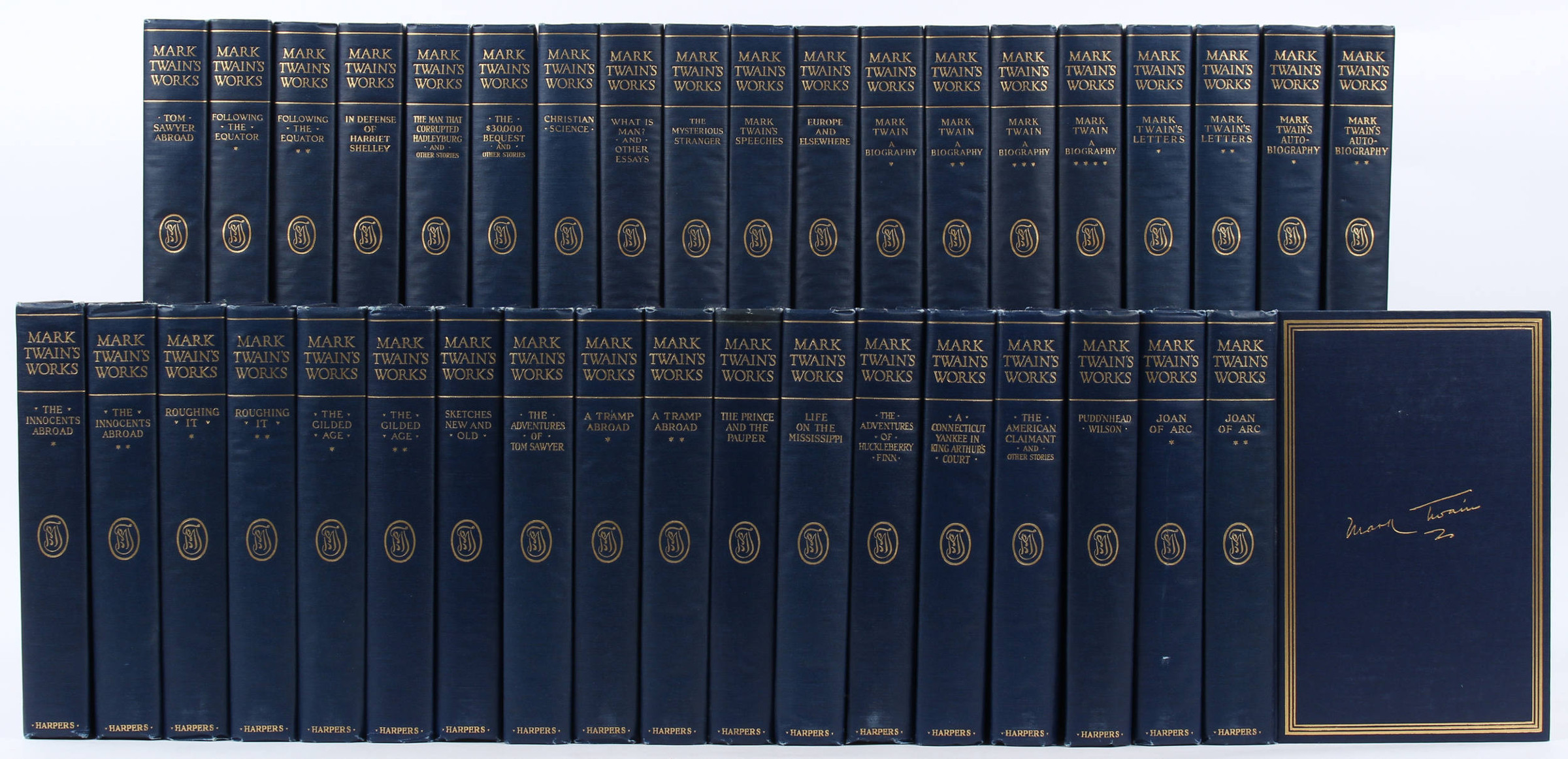
Rare and handsome set of this famous American writer's works, also containing his biography, letters, and his own autobiography. The third uniform edition named after one of Mark Twain's residences: Stormfield, in Redding, Connecticut, was home to Samuel Clemens from June 1908 until his death in April 1910. Volume 22 is titled "In Defense of Harriet Shelley" (retitled from "Literary Essays"). This is number 164 of 1024 numbered copies.
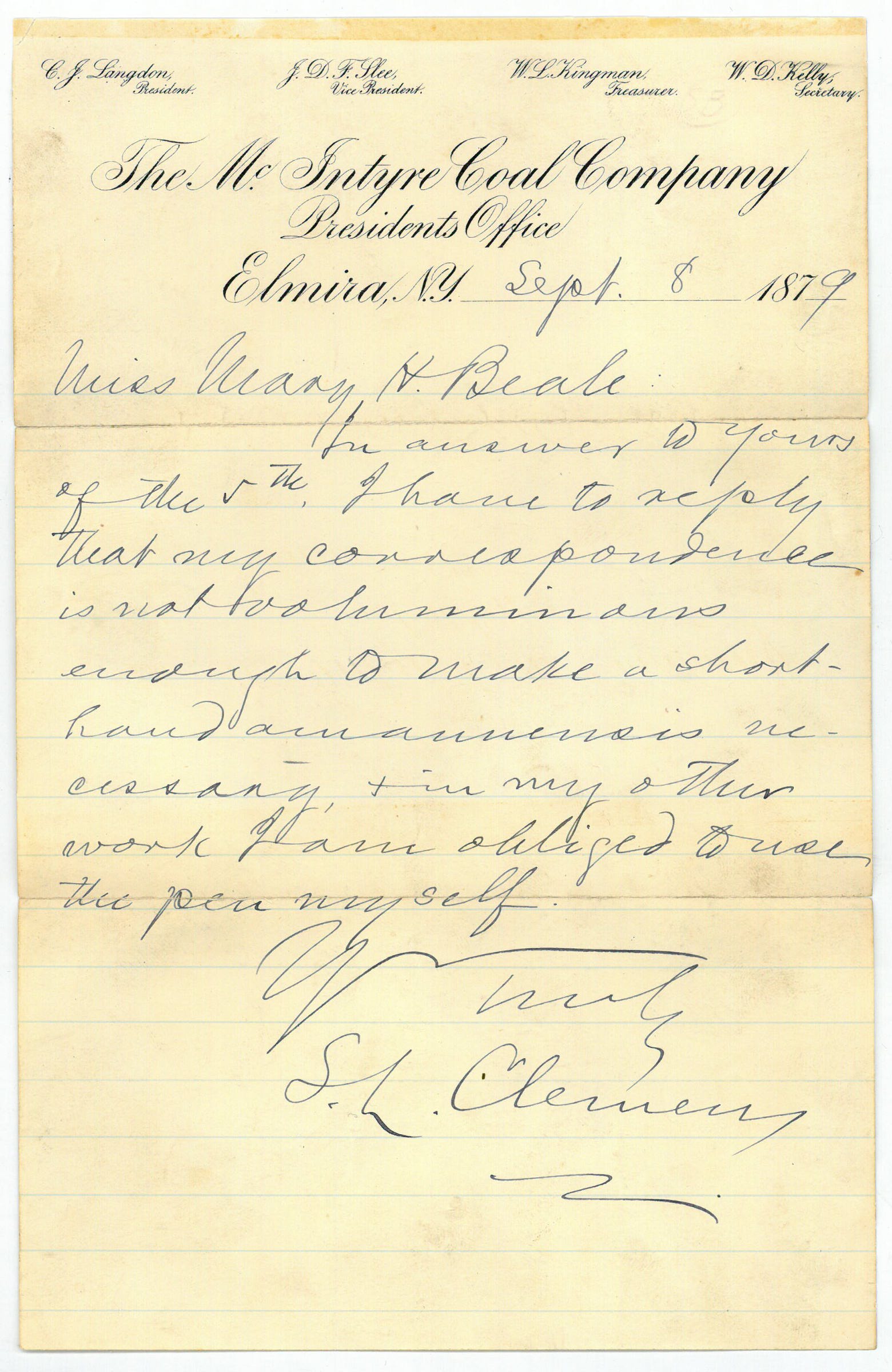
To the stenographer Miss Mary H. Beale, the Clemenses' neighbour in Hartford, Connecticut, who had applied for a position with the famous author: "In answer to yours of the 5th, I have to reply that my correspondence is not voluminous enough to make a short-hand amanuensis necessary, & in my other work I am obliged to use the pen myself".
On lined stationery with printed letterhead of the McIntyre Coal Company, founded by Mark Twain's father-in-law Jervis Langdon.
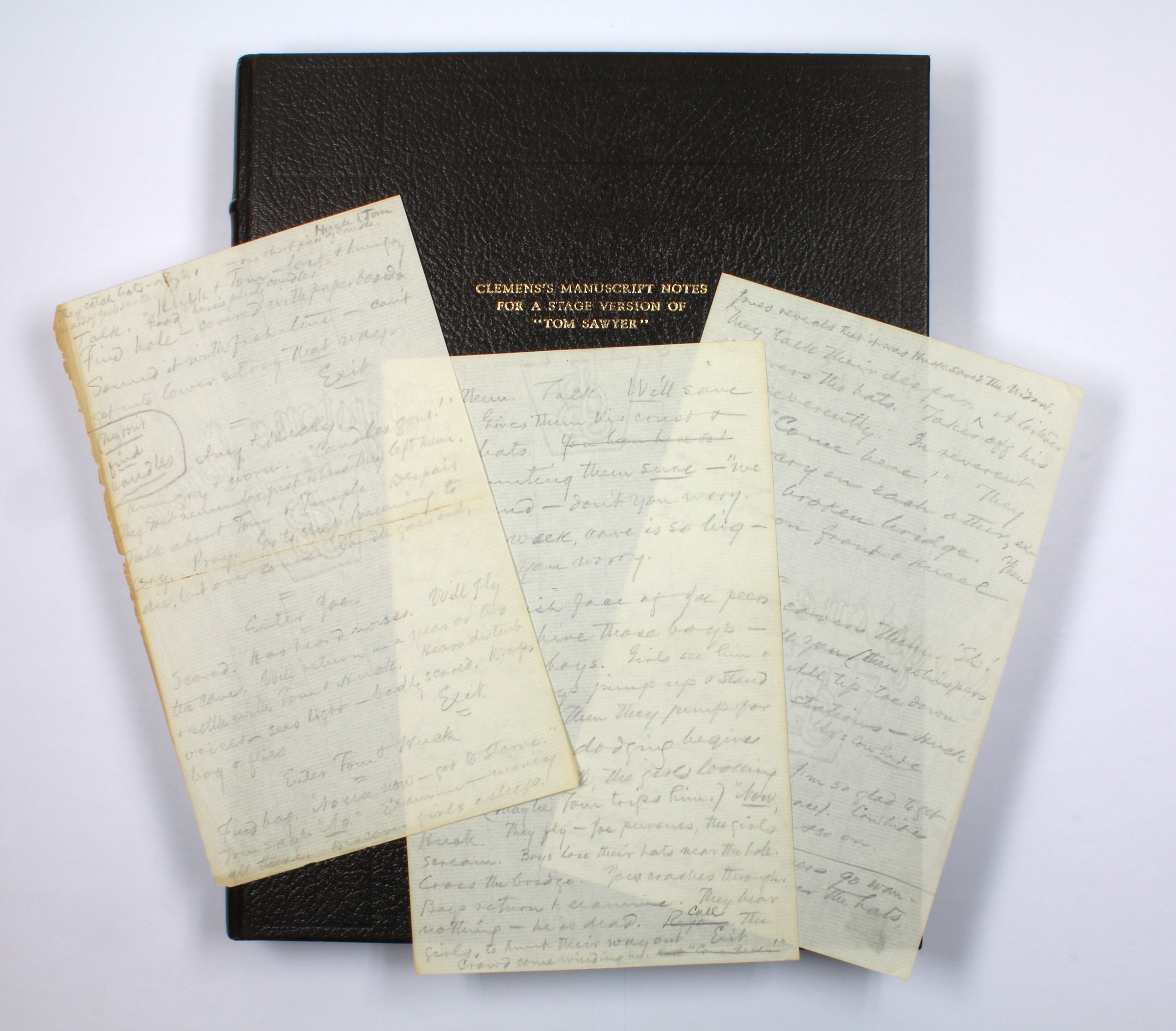
Three leaves from Clemens’s manuscript notes for a never-performed stage version of "Tom Sawyer" completed in early 1884, featuring sketches for the dramatic scene in which Tom, Huck and Becky encounter Injun Joe in the cave. The notes read, in part: "Enter Tom & Huck. Find bag. 'No use now - got to starve.' Tom says 'No.' Examine - money all there. Discover girls asleep. Wake them. Talk. We'll save you. Gives them his crust & some bats [...] Devilish face of Joe peeks out - will hive those boys - steals behind boys. Girls see him & scream. Boys jump up & stand paralyzed. Then they jump for the rock & the dodging begins for life & death, the girls looking over. (Maybe Tom trips him.) 'Now, Huck.' They fly - Joe pursues, the girls scream [...]".
As early as 1875, Clemens had asked his friend William Dean Howells to dramatize the then still-unpublished "Adventures of Tom Sawyer". Howells refused, but Clemens pressed ahead, composed a synopsis of his own to secure copyright and subsequently wrote at least some of the play. While these plans ultimately fell through, in 1883 the author once more attempted to translate his book into a stage success. This time, he managed to complete a dramatic version, and the play was duly copyrighted on 1 February 1884. Although Clemens "was so pleased with this piece of work that even before he had finished it he was pondering on the cast which might properly perform it and trying to dictate terms", the great theatre manager Augustin Daly did not take long to reject the chance to stage "Tom Sawyer", and after this "one hears no more about the author's attempting to dramatize his novel": clearly, Clemens reluctantly came to the conclusion that "his novel just could not be dramatized" (Blair, pp. 250-252).
These are three out of a total of 26 pages of working notes for the play, constituting the last three of a ten-page group termed "C" by their editor, Walter Blair. At the time of Blair's editorial work, the notes were dispersed among several libraries: all but one of this ten-page group (C1-3 and C5-10) were then among the Mark Twain Papers at Bancroft Library, UCA, Berkeley (while C4 rests in Yale University Library). The three pages at hand form a sub-unit that provides a later plan for Act IV, in which Tom and Becky, lost in the cave, encounter Injun Joe.
First page slightly browned along the edges and horizontal fold; folds and paper very lightly frayed. A fine survival of American literature in the author's own hand.
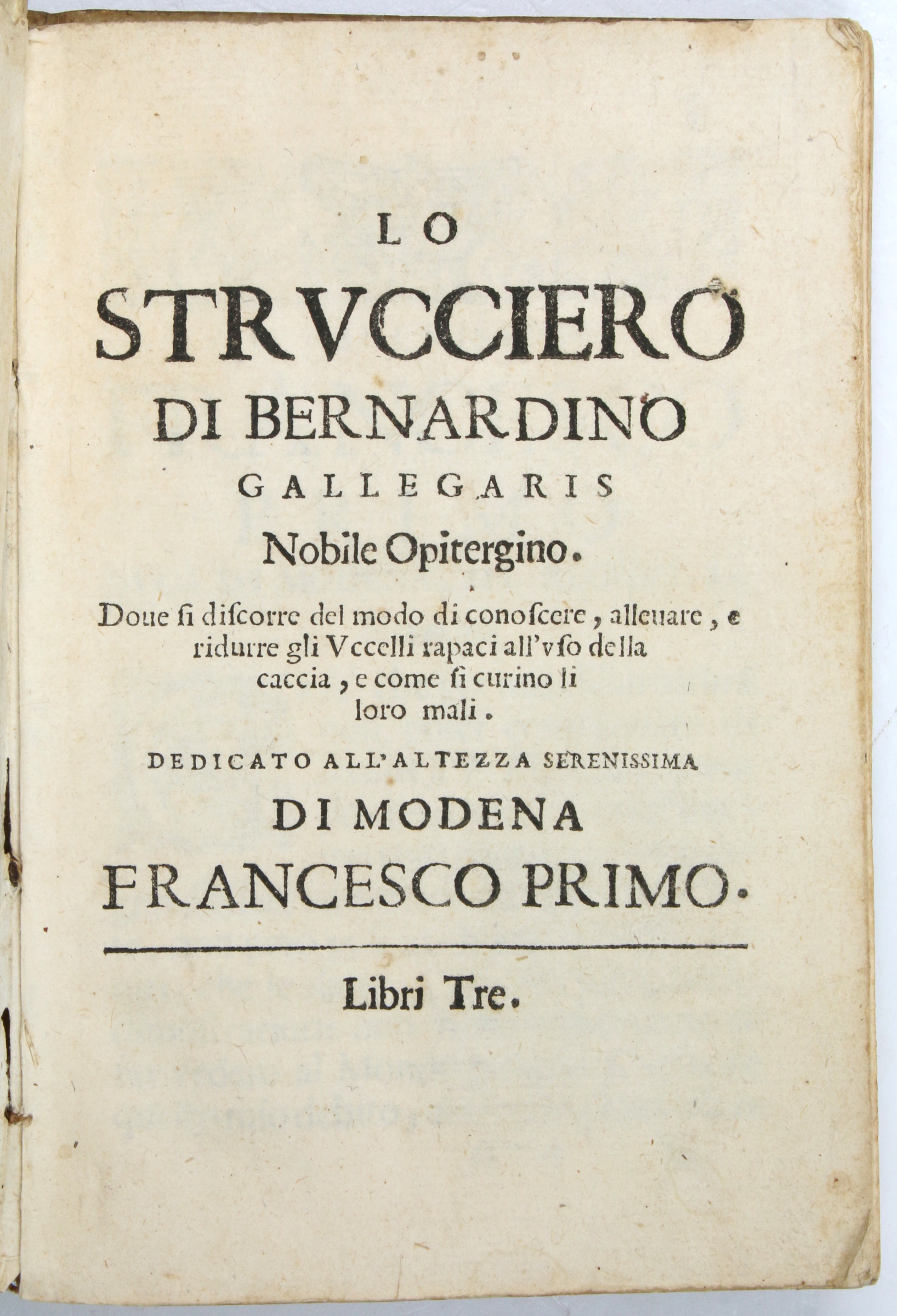
The first edition of "a scarce book on hawking" (Schwerdt). The author asserts that the falcon came originally from Babylonia and that Dancus, king of that country, was the first to recognise its nature. "Rara ... una delle cose classiche della falconeria italiana" (Ceresoli).
Occasional light foxing. A few mispaginations corrected in pencil; old provenance mark from Christie's (15 Dec. 1982) pencilled to lower pastedown.
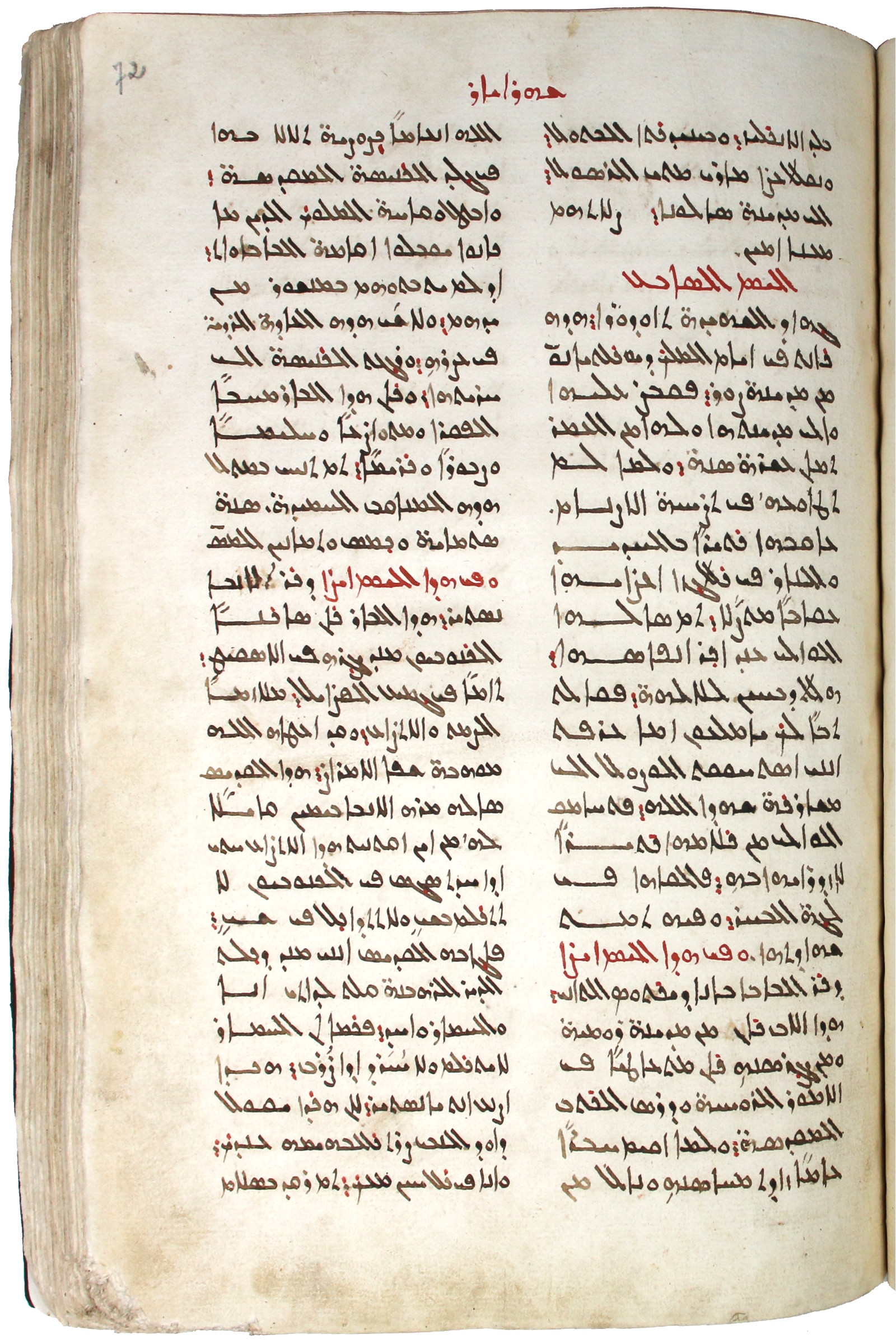
A Gospel manuscript written in Syriac, presumably at the end of 18th century, which belonged to the Maronite community of the Lebanon. Written in serto script on paper produced in Northern Italy at the end of the 18th century, featuring the watermarks of Valentino Galvani (of Pordenone, Friuli) and of Giovanni e Fratelli Andreoli (of Luseti near Brescia). Several contemporary ownerships on the final folio provide a history of the manuscript's circulation: the first mark is from 1799 and identifies the owner as Boutros Noujaim. The manuscript was then most likely donated to the church of Saidet et-Talle, as the following two annotations from the 1850s concern the transfer of the manuscript from the church of Saidet et Talle, located in Deir el-Qamar, to the church of Ain al-Maaser, a village more commonly known as Maaser Beiteddine. These locations near Mount Lebanon suggest that the book was written in the area and show how it was circulated among Lebanese Maronite Christians.
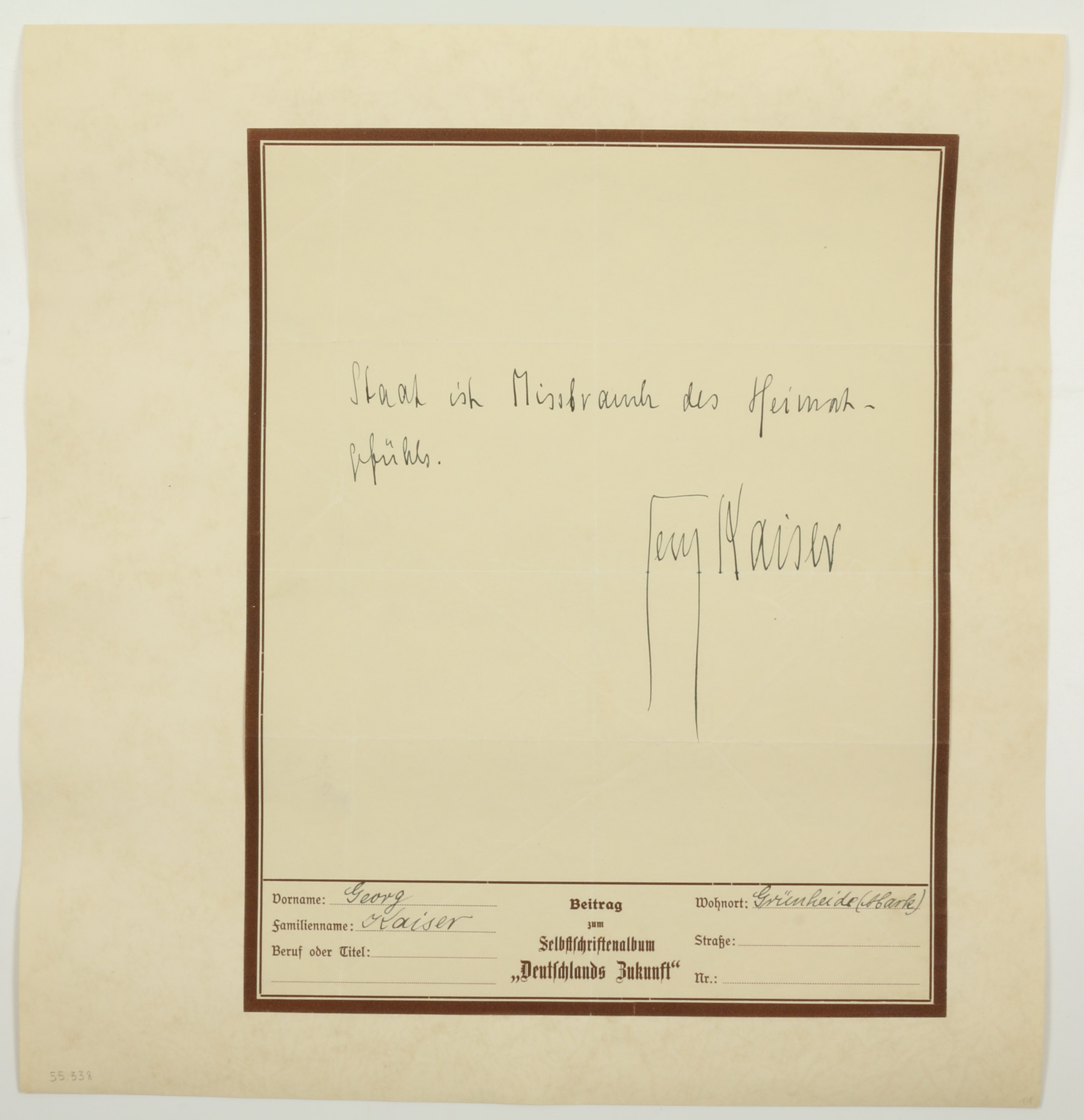
"Staat ist Missbrauch des Heimatgefühls [...]". Geschrieben als Beitrag für die von Friedrich Koslowsky im Berliner Eigenbrödler-Verlag herausgegebene Faksimile-Anthologie "Deutschlands Köpfe der Gegenwart über Deutschlands Zukunft" (1928).
Während der Zeit der Weimarer Republik waren die Theaterstücke des Magdeburger Dramatikers die meistgespielten auf den deutschen Bühnen. Kaiser war bekannt mit Ernst Toller und Bertolt Brecht. Das gemeinsam mit Kurt Weill erarbeitete Stück "Am Silbersee" - Weills letztes Projekt vor seiner Flucht - wurde kurz nach dessen Premiere 1933 wegen Protesten und Boykotten abgesetzt und von der NSDAP verboten.
Mit hs. ausgefülltem Formularteil und hs. Namenszug.
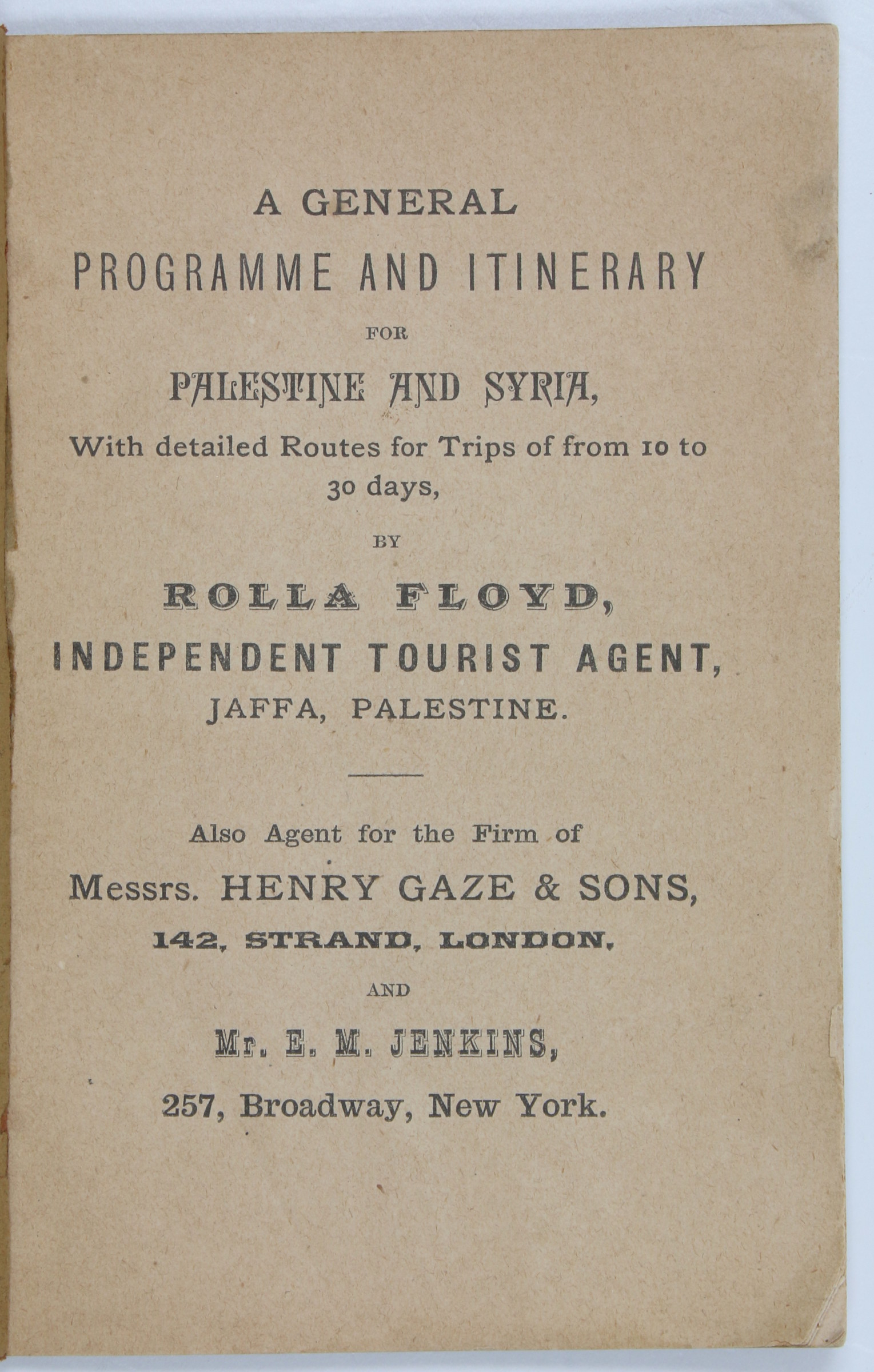
Sole edition of this rare and early guide-book to Palestine and Syria by Rolla Floyd (1838-1911), a maverick American tour-guide in the Middle East.
The itineraries listed here are offered either with or without camp. The first, a two-week tour from Jaffa to Jerusalem, includes stops at Bethlehem, Solomon's pool, Hebron and the Jordan. The second also goes from Jaffa to Jerusalem but via the Sea of Galilee and Nazareth, while the longest 30-day excursions are from Jaffa to Beyrout via Jerusalem, Nazareth, the Sea of Galilee, Damascus and Baalbek.
The first American Dragoman to work within Palestine, the Maine-born Floyd moved to the region shortly after the end of the American Civil War and was a founding member of the American Colony at Jaffa. Once the Colony was abandoned, he relocated to Jerusalem and commenced working as a guide for the Thomas Cook Company. After many successful years in partnership, Floyd fell out with Cook's and set up on his own. So acrimonious was the split that Thomas Cook inserted a clause into all supplier contracts prohibiting any collaboration with Floyd. What might have proved an insurmountable obstacle, in fact neither stopped Floyd from doing well nor from re-joining the firm in 1902. So brilliant was Floyd considered in his role that he served as a guide to Ulysses S. Grant and Mark Twain.
Wrappers chipped with tape repair to verso of upper wrapper. A rare document of the burgeoning tourist trade in the Middle East, and a highly uncommon survival.
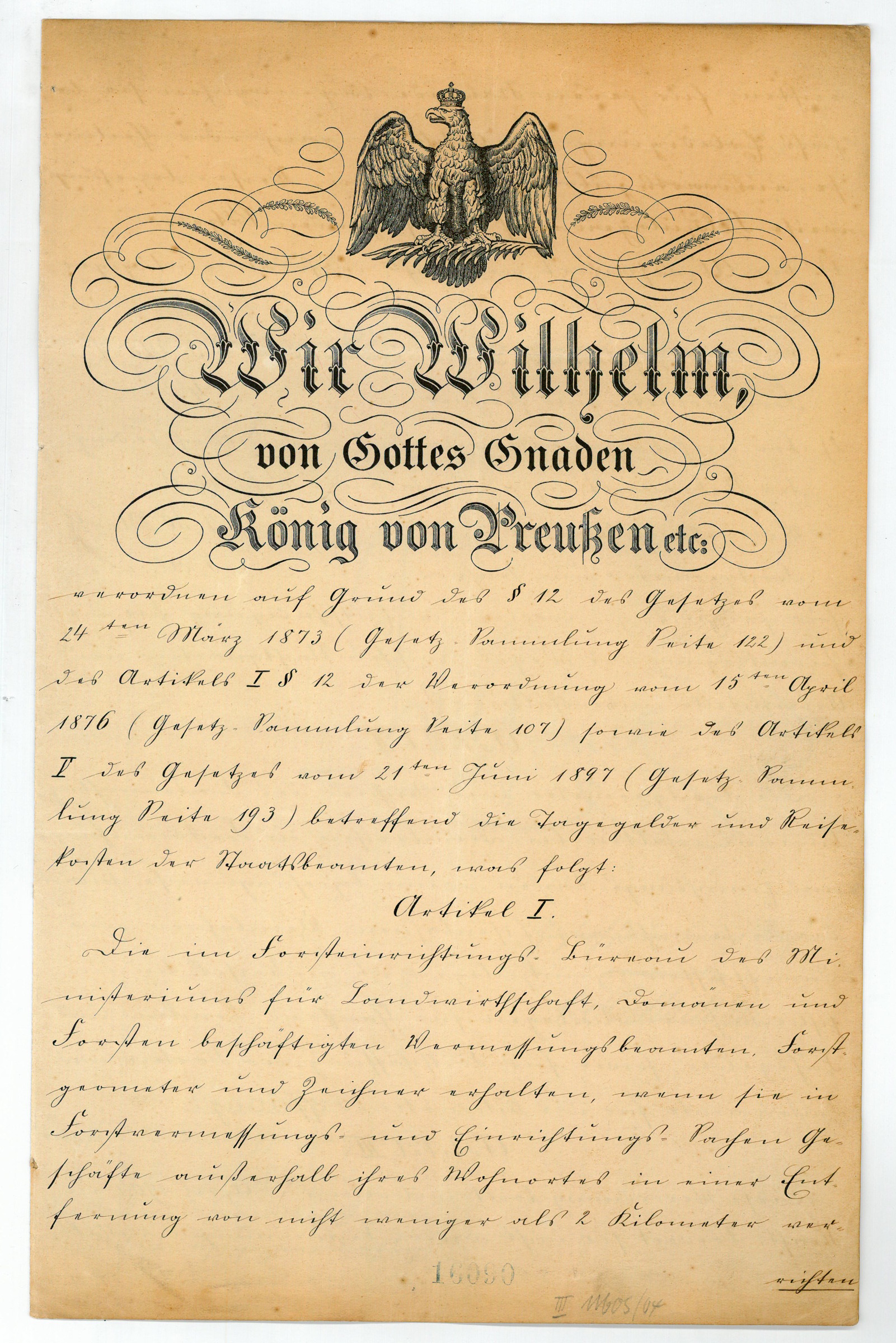
Verordnung über die Reiseentschädigung von Vermessungsbeamten, Forstgeometern und Zeichnern des Landwirtschaftsministeriums mit Bestimmungen zu einem Kilometergeld und zusätzlichen Entschädigungszahlungen nach Tagessätzen bei Arbeitsorten, die mehr als zwei Kilometer vom Wohnort entfernt liegen: "1) Bei Abwesenheit von nicht mehr als eintägiger Dauer / Vermessungsbeamte ... 5 Mark / Forstgeometer und Zeichner ... 4 [Mark] / 2) bei mehrtägiger Abwesenheit und dadurch bedingter Uebernachtung außerhalb des Wohnortes / Vermessungsbeamte ... 5,50 Mark / Forstgeometer und Zeichner ... 5,00 [Mark] [...]".
Mitunterzeichnet von Landwirtschaftsminister Victor von Podbielski (1844-1916). Mit lithogr. Dokumentenkopf und Regestierung. An den Rändern, besonders am oberen, leicht gebräunt; Spuren alter Heftung.

Heinrich von Knigge und Familie beurkunden eine Schuld von 20 Mark Silber Hannoveranischer Währung ("twintich mark lodeghes zulveres Honouerscher wichte und were") bei Margarethe, "husfrouwe" des Conrad von Lude, Bürgers von Hannover. Zahlbar ist die Schuld zum 26. April 1360 bei 10% Zinsen ("to tynse twe mark").
Es bürgen die Herren von Alten, von Winnighusen und von Herbecke.
Zu den prominenten Mitgliedern des seit 1241 bezeugten Geschlechts der Knigge zählt u. a. der Namensgeber des bekannten "Benimmratgebers".
Etwas angestaubt, sonst gut erhalten.
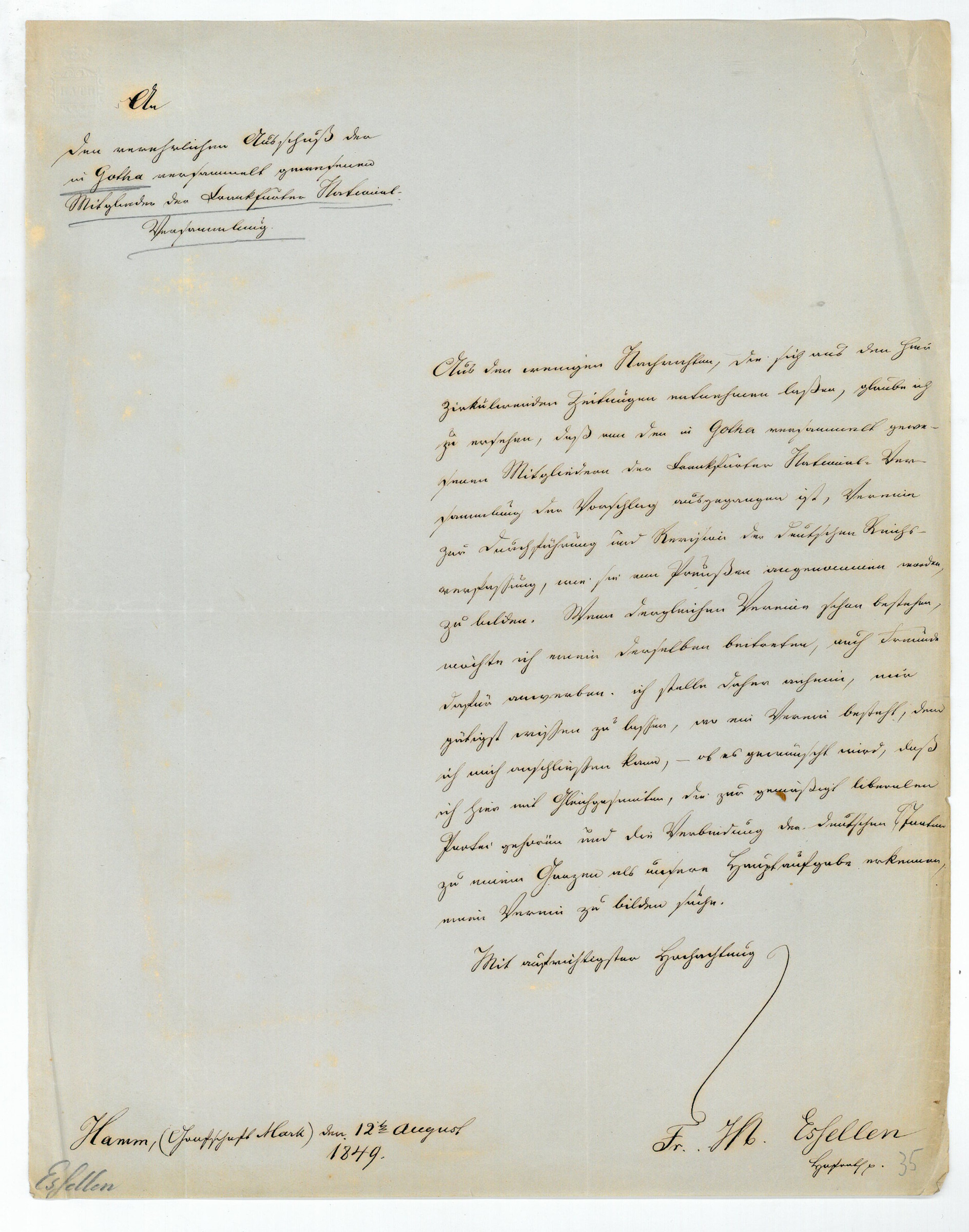
An den "Ausschuß der in Gotha versammelt gewesenen Mitglieder der Frankfurter Nationalversammlung" mit der Bitte um Mitteilung, ob es bereits Vereine zur Überarbeitung der Preußischen Reichsverfassung gebe; Essellen möchte sich zu diesem Zwecke einem liberalen Verein anschließen oder einen solchen gründen: "Aus den wenigen Nachrichten, die sich aus den hier zirkulirenden Zeitungen entnehmen laßen, glaube ich zu ersehen, daß von den in Gotha versammelt gewesenen Mitgliedern der Frankfurter National-Versammlung der Vorschlag ausgegangen ist, Vereine zur Durchführung und Revision der deutschen Reichsverfaßung, wie sie von Preußen angenommen worden, zu bilden [...] ob es gewünscht wird, daß ich hier mit Gleichgesinnten, die zur gemäßigt liberalen Partei gehören und die Verbindung der deutschen Staaten zu einem Ganzen als unsere Hauptaufgabe erkennen, einen Verein zu bilden suche [...]".
M. F. Essellen wurde 1836 zum Hofrat ernannt und war später Kassenrendant am Oberlandesgericht Hamm und Stadtverordneter in Hamm. Er veröffentlichte geschichtliche und archäologische Abhandlungen über u. a. die Römer in Germanien und die Untersuchungen des Gräberfelds Beckum I. Gegen Ende seines Lebens wurde ihm von der Universität Münster die Ehrendoktorwürde verliehen.
Leicht gelbfleckig, an den Rändern leicht gebräunt, der linke Rand leicht lädiert, mit kurzem Randeinriss am oberen Rand. Mit Sammlervermerk in Bleistift.
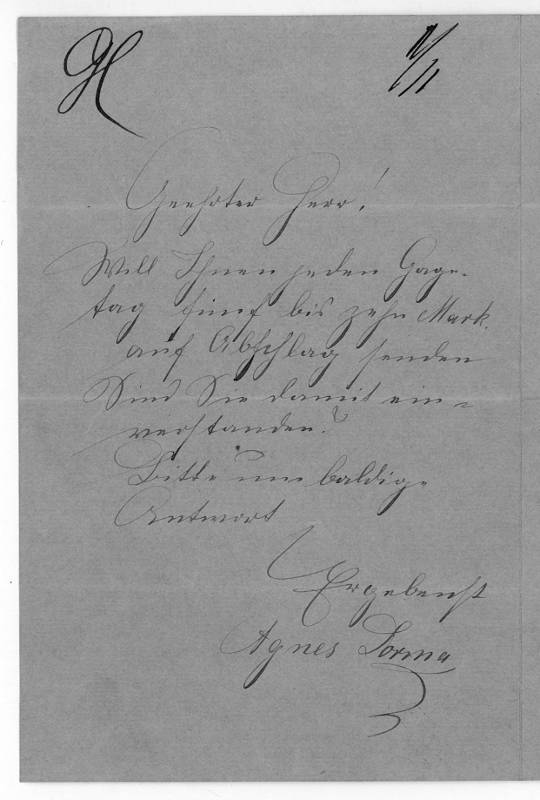
"Will Ihnen jeden Gagetag fünf bis zehn Mark auf Abschlag senden. Sind Sie damit einverstanden? […]".

An den in Forsters Ferienhaus in Bad Aussee weilenden Schauspieler Richard Eybner (1896-1968), dem er u. a. von "einigen Ufa-Pallaver's [!]" berichtet, derentwegen er gerade hier sei.
Seit 1903 auf der Bühne stehend, begann Forster 1919 in Stummfilmen mitzuwirken; sein erster Tonfilm folgte 1930 mit der "Dreigroschenoper" unter der Regie von G. W. Pabst. Einem kurzzeitigen Engagement am Broadway folgten weitere Filme und wenige Theaterauftritte. Nach dem Zweiten Weltkrieg war Forster vorwiegend im Theater in der Josefstadt zu sehen und wie schon zuvor im Film, wo er u. a. in einigen Edgar Wallace-Verfilmungen zu sehen war.
In altem Sammlungsumschlag.

Quittiert den Erhalt von 400 Mark für seine Novelle "Damals wie heute".
Papierbedingt etwas gebräunt und mit kleinen Randläsuren.
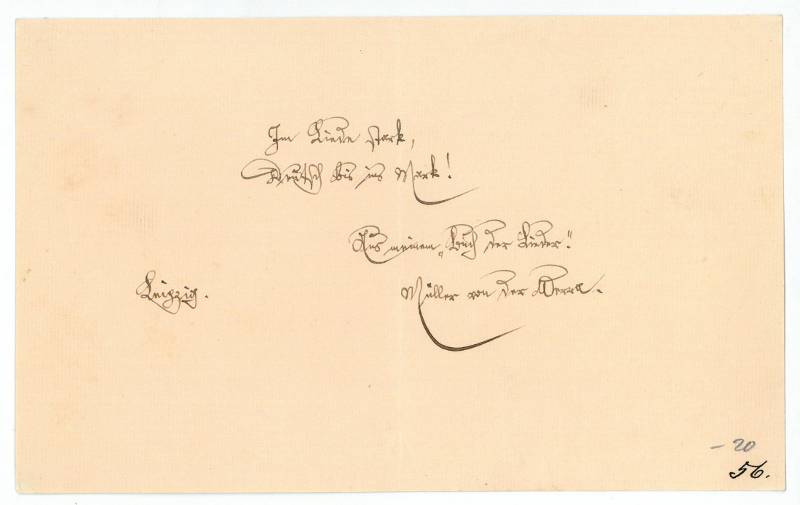
"Im Liede stark, / Deutsch bis ins Mark! / Aus meinem 'Buch der Lieder' [...]".
Verso alter Sammlervermerk in roter Tinte: "21. Juli 1879 erh.".
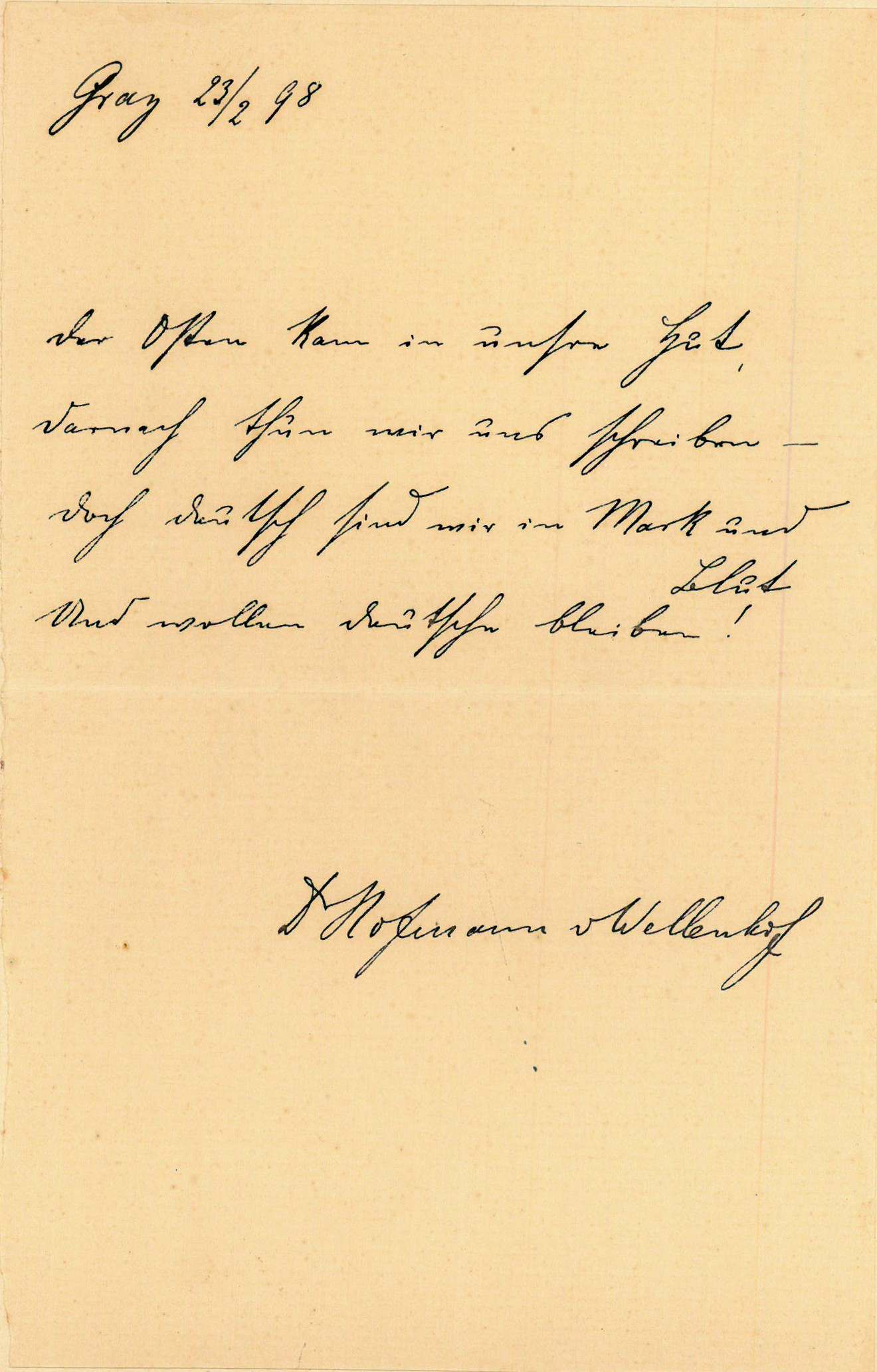
"Der Osten kam in unsre Hut, | Darnach thun wir uns schreiben - | Doch deutsch sind wir in Mark und Blut | Und wollen Deutsche bleiben!" - Alt auf Trägerpapier montiert.
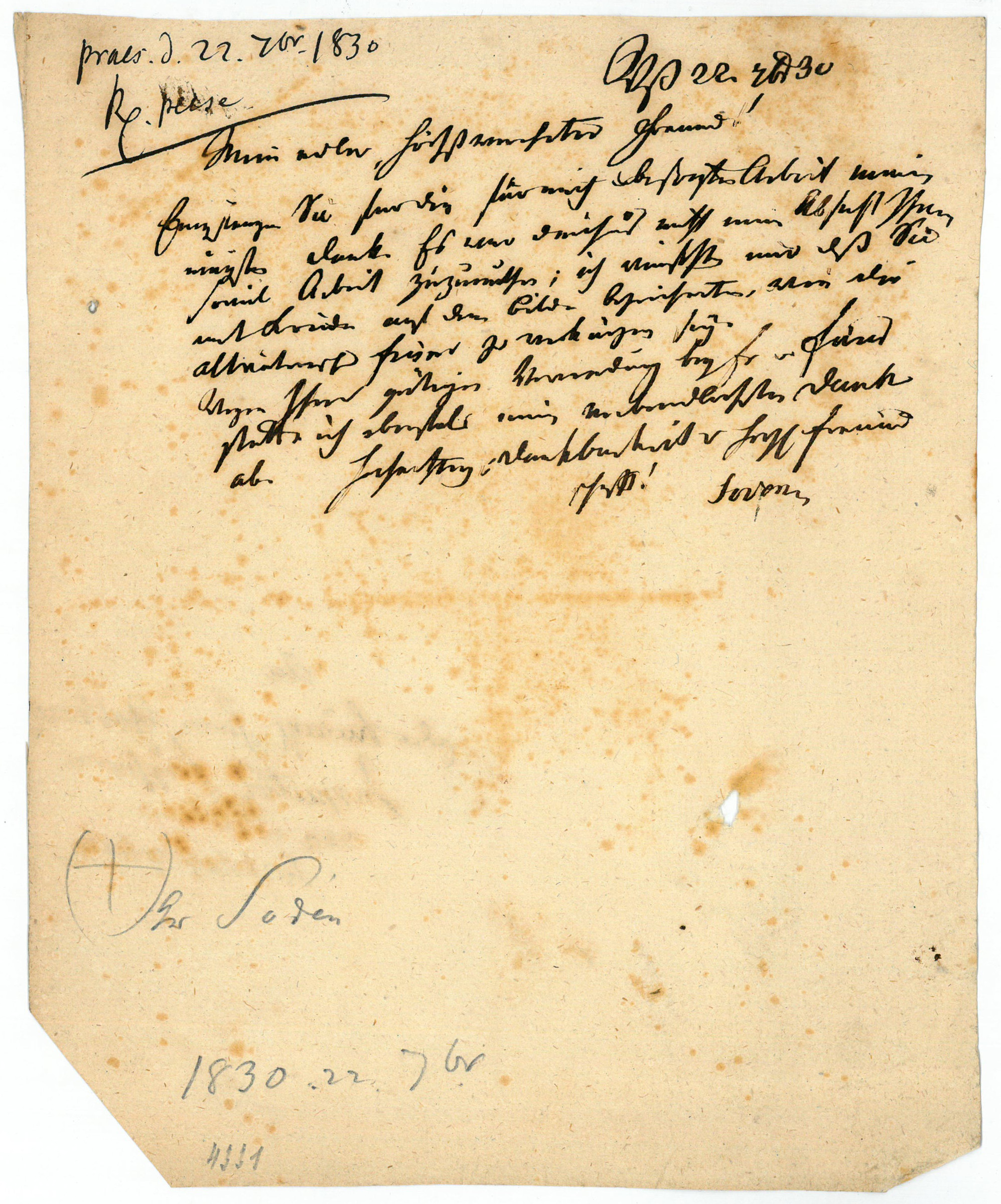
To Count Haller, asking to mark some figures he had sent him.
Slight damage to edges.
















